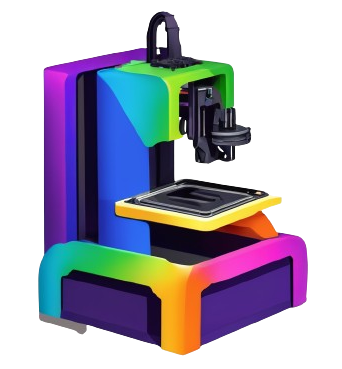Ever wondered how 3D printing can be a game-changer in the fight against carbon emissions? By utilizing additive manufacturing techniques, you can significantly cut down on waste materials and energy consumption. Consider how each layer in 3D printing is precise and only uses the exact amount of material needed – a far cry from traditional manufacturing’s excess. When you opt for 3D printing, not only do you streamline production, but you also contribute to a greener, more sustainable future. Your choice in technology truly matters in reducing our carbon footprint.
Key Takeaways
- Reduced waste: 3D printing creates less waste compared to traditional manufacturing processes, as it only uses the materials necessary for the end product.
- Local production: 3D printing allows for localized manufacturing, reducing the need for transporting products over long distances and lowering carbon emissions from transportation.
- Efficient design: 3D printing enables the production of complex geometries and lightweight structures, leading to more efficient designs that can reduce material usage and energy consumption.
The Environmental Impact of Traditional Manufacturing
Greenhouse Gas Emissions from Production
While traditional manufacturing processes have been the backbone of industry for centuries, they come with a significant environmental cost. The production of goods through traditional methods often involves high levels of greenhouse gas emissions. These emissions primarily stem from the burning of fossil fuels like coal, oil, and natural gas to power manufacturing plants and machinery.
Greenhouse gas emissions from traditional manufacturing contribute to global warming and climate change. The release of carbon dioxide (CO2) and other greenhouse gases into the atmosphere traps heat, leading to the warming of the planet. As a result, traditional manufacturing processes play a substantial role in exacerbating environmental issues and increasing carbon footprints.
Resource Depletion and Waste Generation
Any manufacturing process that relies heavily on extracting and processing raw materials contributes to resource depletion and waste generation. Traditional manufacturing methods often require large amounts of natural resources like minerals, metals, and water, leading to environmental degradation and ecosystem disruption. Additionally, the disposal of waste materials from manufacturing processes further compounds environmental challenges.
It is estimated that traditional manufacturing generates vast quantities of waste, including byproducts, scraps, and unused materials. This waste not only pollutes the air, water, and soil but also leads to the depletion of natural resources. The linear ‘take-make-dispose’ model of traditional manufacturing perpetuates a cycle of resource extraction, production, and waste generation that is unsustainable in the long run.
The Rise of 3D Printing
Any revolutionary technology starts with a spark, a small idea that grows into something transformative. 3D printing, also known as additive manufacturing, has been the quiet disruptor in the manufacturing world. With its ability to create complex designs layer by layer, 3D printing offers a sustainable alternative to traditional manufacturing methods. This technology is reshaping production processes and supply chains, leading to reduced carbon emissions and environmental impact.
Additive Manufacturing: A Sustainable Alternative
For industries looking to reduce their carbon footprint, additive manufacturing provides a more sustainable alternative. By precisely depositing material only where needed, 3D printers waste less material compared to traditional subtractive manufacturing methods. This efficiency not only cuts costs but also reduces environmental impact by minimizing material waste. As companies strive to meet sustainability goals, 3D printing offers a greener solution for manufacturing diverse products.
Reduced Material Consumption and Waste
Material consumption and waste are major concerns in traditional manufacturing. Excess materials often end up in landfills, contributing to environmental degradation. 3D printing addresses this issue by using only the necessary amount of material for each project. Unlike traditional manufacturing, where excess material is common, 3D printing builds products layer by layer, optimizing material usage. This reduction in material consumption not only benefits the environment but also improves efficiency in production processes. With 3D printing, you can create intricate designs with minimal waste, making a positive impact on the planet.
3D printing optimizes material usage by building objects layer by layer, reducing waste significantly. Unlike traditional manufacturing methods, where excess material is common, 3D printing only uses the amount of material required for the specific design. This efficiency in material consumption not only contributes to a greener manufacturing process but also saves costs for businesses in the long run.
Carbon Footprint Reduction through 3D Printing
Energy Efficiency in 3D Printing Processes
Despite the technological advancements in 3D printing, one of the key aspects that make it environmentally friendly is its energy efficiency. An imperative feature of 3D printing is additive manufacturing, which builds objects layer by layer, only using the material needed. This process contrasts with traditional manufacturing methods that often involve subtractive processes, where excess material is cut away, leading to wastage. Consequently, 3D printing minimizes energy consumption by reducing material waste and energy-intensive processes.
Localized Production and Reduced Transportation Emissions
Emissions from transportation contribute significantly to carbon footprints globally. Through localized production facilitated by 3D printing, you can reduce the need for shipping finished products over long distances. By being able to manufacture items closer to the end consumer, you lower greenhouse gas emissions generated from transportation. Additionally, 3D printing allows for on-demand production, meaning items are made as needed, reducing excess inventory and further decreasing transportation-related carbon emissions.
Production via traditional methods often involves mass production in centralized locations, necessitating shipments to various destinations. In contrast, 3D printing enables distributed manufacturing, where products can be made locally or even at the point of consumption, thereby minimizing the environmental impact of transportation. This shift towards localized production not only decreases carbon emissions but also promotes sustainable practices in the manufacturing industry.
Supply Chain Optimization
Reduced Inventory and Storage Needs
Optimization of the supply chain is a critical aspect of reducing carbon emissions through 3D printing. With traditional manufacturing methods, large quantities of inventory need to be produced in advance and stored in warehouses. This not only takes up space but also requires additional energy for transportation and storage. However, with 3D printing, products can be manufactured on-demand, eliminating the need for excessive inventory and reducing the carbon footprint associated with storage and transportation.
Just-in-Time Production and Minimal Waste
Optimization in 3D printing facilitates just-in-time production, where items are manufactured only when they are needed. This lean manufacturing approach minimizes waste by avoiding overproduction and excess inventory. With traditional manufacturing, excess materials often end up as waste, contributing to environmental pollution. 3D printing allows for precise control over the amount of material used in production, resulting in minimal waste and a more sustainable manufacturing process.
For instance, imagine a scenario where a company utilizing traditional manufacturing methods produces more products than demanded, leading to excess inventory that eventually becomes obsolete. This excess inventory not only ties up resources but also results in waste when the products are disposed of. However, with 3D printing, you can manufacture products as needed, reducing the likelihood of overproduction and minimizing waste, thus decreasing the carbon footprint of the manufacturing process.
Design for Sustainability
Optimized Product Design for Minimal Material Use
Keep in mind that one of the key ways 3D printing helps reduce carbon emissions is through optimized product design for minimal material use. With traditional manufacturing methods, there is often a lot of wasted material in the production process. However, with 3D printing, you have the ability to create intricate designs with only the necessary amount of material required, minimizing waste significantly.
Biodegradable and Recyclable Materials in 3D Printing
Optimized for sustainability, 3D printing allows for the use of biodegradable and recyclable materials. PLA (polylactic acid) is one such material commonly used in 3D printing that is derived from plant-based sources such as corn starch or sugar cane. Additionally, materials like PETG (Polyethylene Terephthalate Glycol) are recyclable and can be melted down and reused in the production of new items, reducing the demand for new raw materials and lowering carbon emissions associated with manufacturing processes.
Plus, by utilizing biodegradable and recyclable materials in 3D printing, you contribute to the circular economy by reducing waste and promoting sustainability in manufacturing. This not only benefits the environment but also encourages a shift towards more eco-friendly practices in the industry.
Industry Applications and Success Stories
Aerospace and Automotive Industries’ Adoption of 3D Printing
All industries are looking for ways to reduce their carbon footprint, and the aerospace and automotive sectors are no exception. By adopting 3D printing technologies, these industries have been able to significantly decrease their waste production and energy consumption. With 3D printing, parts can be customized and optimized for performance, leading to lighter components that require less fuel for operation. This innovation has not only reduced carbon emissions but also improved the overall efficiency and sustainability of these industries.
Medical and Healthcare Applications of Sustainable 3D Printing
The healthcare sector has also embraced the sustainable aspects of 3D printing. From prosthetics to personalized medical devices, 3D printing allows for the production of complex and customized items with minimal material wastage. This technology has revolutionized the field by enabling faster and more cost-effective production of medical tools and implants. Additionally, the ability to create patient-specific models has enhanced surgical planning and outcomes, ultimately reducing the overall environmental impact of healthcare practices.
The medical and healthcare industries are continuously exploring new ways to incorporate sustainable practices into their operations. With the help of 3D printing, healthcare professionals can minimize their carbon footprint by producing precise and customized solutions that meet the specific needs of patients. This not only enhances the quality of care but also contributes to a greener and more eco-friendly healthcare system.
Summing up
In the final consideration, 3D printing offers a range of environmental benefits that help reduce carbon emissions. By enabling more localized production, less material wastage, and streamlined supply chains, 3D printing presents a sustainable alternative to traditional manufacturing methods. Embracing this technology not only contributes to a greener future but also opens up new possibilities for innovation and efficiency in various industries. Consider how you can harness the power of 3D printing to make a positive impact on the environment and reduce your carbon footprint.
Q: How does 3D printing reduce carbon emissions?
A: 3D printing reduces carbon emissions in several ways. First, it allows for more efficient use of materials, as only the exact amount needed is used in the printing process, reducing waste. Second, 3D printing can localize production, reducing the need for transporting goods long distances, which in turn reduces the carbon footprint associated with transportation. Lastly, 3D printing enables on-demand production, meaning products are only made when needed, further reducing excess production and waste.
Q: What are some examples of industries using 3D printing to reduce carbon emissions?
A: Several industries are utilizing 3D printing to lower their carbon emissions. For example, the automotive industry is using 3D printing to produce lighter components, reducing fuel consumption and emissions. The aerospace industry is also benefiting from 3D printing by creating more efficient and lightweight parts for aircraft, leading to lower emissions. Additionally, the fashion industry is exploring 3D printing as a sustainable alternative to traditional manufacturing processes.
Q: Are there any challenges to implementing 3D printing for carbon emissions reduction?
A: While 3D printing offers many benefits for reducing carbon emissions, there are challenges to its widespread implementation. One challenge is the limited range of materials available for 3D printing compared to traditional manufacturing processes, which may limit its application in certain industries. Additionally, the cost of 3D printing technology and materials can be prohibitive for some businesses. There are also concerns about the environmental impact of the materials used in 3D printing, such as plastics, and efforts are being made to develop more sustainable alternatives.

